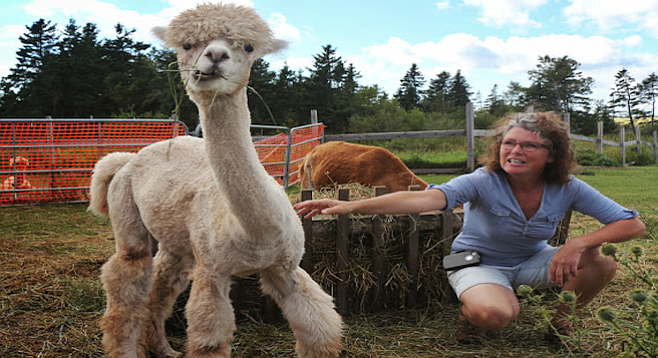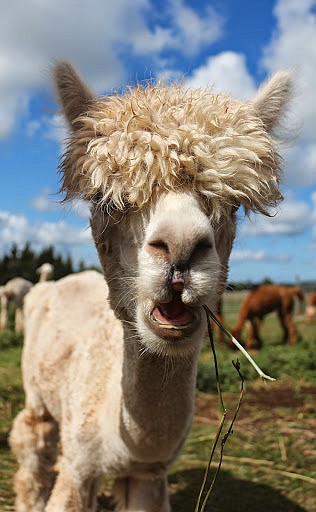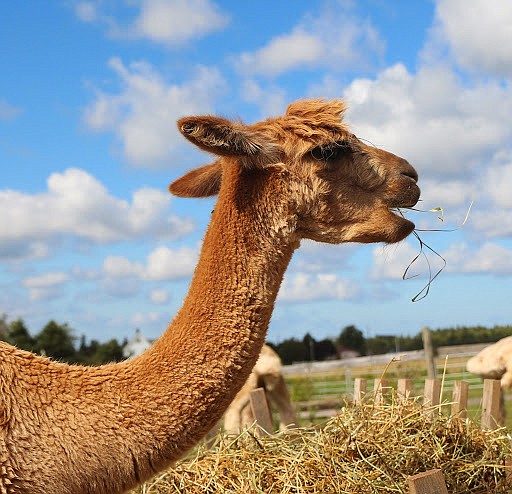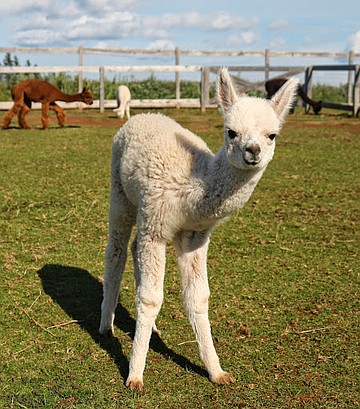 Facebook
Facebook
 X
X
 Instagram
Instagram
 TikTok
TikTok
 Youtube
Youtube


Grass and girls. That was what life was all about, at least viewed through the black, bulby eyes of Keswick, a seven-year-old alpaca. His muppet-like neck bobbing in front of my wife and me, Keswick noisily nibbled at pasture in the flatlands of western Prince Edward Island.
“He loves the ladies,” said Janet Ogilvie, owner of Green Gable Alpacas, as Keswick stole glances at the females through the fence.
After we’d strolled along Prince Edward Island’s renowned Martian-red beaches and overdosed on the island’s bountiful seafood – including silky oysters and surprisingly inexpensive lobster (a dinner for two featuring two tender lobsters starts at CAD $22) – the owners of our bed & breakfast in the city of Summerside had told us of a nearby ranch that would introduce us to the island’s agricultural side. We now found ourselves surrounded by Ogilvie’s herd of thirty-eight alpacas.
Why bring a camelid species native to the Andean highlands to a flat Canadian island? One stroke of Keswick’s neck made it clear to me: the fleece. Alpaca fleece is fine and soft without sacrificing strength, and provides warmth without itchiness.

Ogilvie led us to the building where she sorts the fleece by color and quality. Swirls of fleece – from pearly white to Chewbacca brown to dark chocolate – poked from the openings of giant plastic bags. She handed us a length of Keswick’s chestnut blonde fleece and remarked, “If this was a sheep fleece, it would stink and you would not put your hands in it because it would be very greasy.”
Any natural fiber less than thirty microns in diameter is acceptable for clothing. The thinner the fiber, the more luxurious it feels. Keswick’s fibers measured in at 16.4 microns. “If you have an animal less than twenty microns, you’re like, ‘Woohoo! Yippee!’” she chirped. The average adult human hair is 75 to 150 microns, which is why you don’t see people eagerly cutting off their ponytails to make scarves.

Ogilvie guided us into the female’s paddock where she activated her secret alpaca magnet: the garden hose. “C’mon girls!” she yelled as she sprayed an arcing jet of water. Immediately, several alpacas moseyed toward her. “The water helps them cool off,” she said. Hemmed in by fur and snout, I became fascinated by the variety of personalities among the herd. One female, Margrite, stood right in front of Ogilvie. “Margrite hates people, but she’ll come right up to you if you have the hose.” Another alpaca, Shilo, whose unshorn head bestowed her with a spiky hairdo worthy of Invincible-era Pat Benatar, approached and nudged my wife and me with tender curiosity, even though we were pitifully hoseless.
The boys, posing pensively in their own paddock, seemed content, all wearing the species’ built-in grin. Despite having such charming names as Klondike, Hawthorne, and Kahlua, they reserve visceral venom for one another. “They push to get the other on the ground. They’re actually trying to bite at one another’s testicles,” Ogilvie said. At two years old, alpaca males grow short, sharp teeth. “They’re called fighting teeth for a reason. We cut them off. The boys can emasculate one another.”
There would be more alpaca skirmishes if it weren’t for Grizwald, the ranch’s only llama, who has a foot of height over the boys. He only has to stick his thick neck between fighters to break up a rumble. “He’s the bouncer,” Ogilvie said. In addition to serving as the protector of camelid family jewels, Grizwald is quite the apple aficionado. Ogilvie encouraged me to feed him a slice. I barely felt the gentle probing of his lips as he plucked the slice from my palm.
Under the wooden ceiling of what used to be a milking room in the farm’s past life, Ogilvie sells scarves, hats, and slippers that she and her mother have knitted. Just as fair trade coffee and chocolate companies personalize packaging with the picture of the farmer who grew the crop, Ogilvie wraps each bundle of alpaca yarn in a label emblazoned with the mugshot of the originating animal.

My wife left with a piece of the island around her neck: a buttery-soft scarf of yarn spun from Keswick’s fleece. It’s the same fleece that scores him date after date with females brought in from nearby ranches whose owners pay for a shot at that money fur.
I realized that the world of alpaca farming is refreshingly egalitarian – even the boys are judged by their hair.



Grass and girls. That was what life was all about, at least viewed through the black, bulby eyes of Keswick, a seven-year-old alpaca. His muppet-like neck bobbing in front of my wife and me, Keswick noisily nibbled at pasture in the flatlands of western Prince Edward Island.
“He loves the ladies,” said Janet Ogilvie, owner of Green Gable Alpacas, as Keswick stole glances at the females through the fence.
After we’d strolled along Prince Edward Island’s renowned Martian-red beaches and overdosed on the island’s bountiful seafood – including silky oysters and surprisingly inexpensive lobster (a dinner for two featuring two tender lobsters starts at CAD $22) – the owners of our bed & breakfast in the city of Summerside had told us of a nearby ranch that would introduce us to the island’s agricultural side. We now found ourselves surrounded by Ogilvie’s herd of thirty-eight alpacas.
Why bring a camelid species native to the Andean highlands to a flat Canadian island? One stroke of Keswick’s neck made it clear to me: the fleece. Alpaca fleece is fine and soft without sacrificing strength, and provides warmth without itchiness.

Ogilvie led us to the building where she sorts the fleece by color and quality. Swirls of fleece – from pearly white to Chewbacca brown to dark chocolate – poked from the openings of giant plastic bags. She handed us a length of Keswick’s chestnut blonde fleece and remarked, “If this was a sheep fleece, it would stink and you would not put your hands in it because it would be very greasy.”
Any natural fiber less than thirty microns in diameter is acceptable for clothing. The thinner the fiber, the more luxurious it feels. Keswick’s fibers measured in at 16.4 microns. “If you have an animal less than twenty microns, you’re like, ‘Woohoo! Yippee!’” she chirped. The average adult human hair is 75 to 150 microns, which is why you don’t see people eagerly cutting off their ponytails to make scarves.

Ogilvie guided us into the female’s paddock where she activated her secret alpaca magnet: the garden hose. “C’mon girls!” she yelled as she sprayed an arcing jet of water. Immediately, several alpacas moseyed toward her. “The water helps them cool off,” she said. Hemmed in by fur and snout, I became fascinated by the variety of personalities among the herd. One female, Margrite, stood right in front of Ogilvie. “Margrite hates people, but she’ll come right up to you if you have the hose.” Another alpaca, Shilo, whose unshorn head bestowed her with a spiky hairdo worthy of Invincible-era Pat Benatar, approached and nudged my wife and me with tender curiosity, even though we were pitifully hoseless.
The boys, posing pensively in their own paddock, seemed content, all wearing the species’ built-in grin. Despite having such charming names as Klondike, Hawthorne, and Kahlua, they reserve visceral venom for one another. “They push to get the other on the ground. They’re actually trying to bite at one another’s testicles,” Ogilvie said. At two years old, alpaca males grow short, sharp teeth. “They’re called fighting teeth for a reason. We cut them off. The boys can emasculate one another.”
There would be more alpaca skirmishes if it weren’t for Grizwald, the ranch’s only llama, who has a foot of height over the boys. He only has to stick his thick neck between fighters to break up a rumble. “He’s the bouncer,” Ogilvie said. In addition to serving as the protector of camelid family jewels, Grizwald is quite the apple aficionado. Ogilvie encouraged me to feed him a slice. I barely felt the gentle probing of his lips as he plucked the slice from my palm.
Under the wooden ceiling of what used to be a milking room in the farm’s past life, Ogilvie sells scarves, hats, and slippers that she and her mother have knitted. Just as fair trade coffee and chocolate companies personalize packaging with the picture of the farmer who grew the crop, Ogilvie wraps each bundle of alpaca yarn in a label emblazoned with the mugshot of the originating animal.

My wife left with a piece of the island around her neck: a buttery-soft scarf of yarn spun from Keswick’s fleece. It’s the same fleece that scores him date after date with females brought in from nearby ranches whose owners pay for a shot at that money fur.
I realized that the world of alpaca farming is refreshingly egalitarian – even the boys are judged by their hair.
Comments